
Many of the books featured in our current exhibition LGBTQI Literature: Celebrated Classics and Contemporary Works have been adapted into acclaimed movies and TV miniseries. From eighties costume drama Brideshead Revisited to this spring’s HBO film The Normal Heart, the stories of people who identify as LGBTQI have made for compelling drama on the big and small screen.
With the dog days of summer upon us, we recommend that you come view the exhibition, stop off for lunch or dinner at Eric’s Restaurant on campus, and then unwind at home with one of the following:
Those who are suffering from Downton Abbey withdrawal might enjoy the British miniseries Brideshead Revisited (1981), the tale of a friendship that develops between two young men at Oxford in the decade following WWI. Based on the novel by Evelyn Waugh, Brideshead… made a star of Jeremy Irons.
Desert Hearts (1985), directed by Donna Deitch and based on the novel Desert of the Heart by Jane Rule, is considered a classic of lesbian film. It centers on the realistic romance between divorcing housewife Vivian and casino worker Cay in Reno, Nevada.
Steven Spielberg directed The Color Purple (1985), an adaptation of the Pulitzer Prize-winning novel by Alice Walker. In it, main character Celie (played by Whoopi Goldberg) finds her life changed by an affair with the beautiful blues singer Shug.
Armistead Maupin’s Tales of the City (1993) was the first of three miniseries based on the writer’s popular books about life in a San Francisco apartment building in the 1970s. It starred a less well-known Laura Linney as the naive new tenant Mary Ann, and Olympia Dukakis as landlady Mrs. Madrigal. Various straight and gay neighbors with their own stories rounded out the characters.
The script for the two-part HBO production of Angels in America (2003) was adapted by Tony Kushner from his play about the AIDS epidemic in Reagan’s America. Angels… won 11 Emmy Awards including acting nods for Al Pacino as closeted conservative attorney Roy Cohn, and Jeffrey Wright as the compassionate nurse Belize.
Brokeback Mountain (2005) started out as a story by Annie Proulx in her 1999 collection Close Range: Wyoming Stories. The tale of two ranch hands who fall in love was adapted into a full-length screenplay by Larry McMurtry and his writing partner Diana Ossana. The Ang Lee-directed film starred Jake Gyllenhaal and the late Heath Ledger as the star-crossed Western lovers.
In May 2014, miniseries The Normal Heart debuted on HBO. Based on Larry Kramer’s 1985 play about activism during the early years of the AIDS crisis, it starred Mark Ruffalo and Julia Roberts, and will be released on DVD later this month.
LGBTQI Literature: Celebrated Classics and Contemporary Works will be on view on the 1st floor of MD Anderson Library through Sept. 26, 2014.
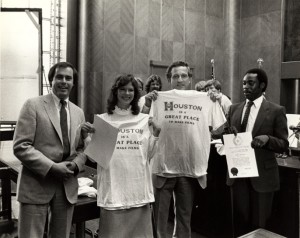
“Houston is a Great Place to Make Films” / from the production of Adam, pictured left to right, Steve Moore of GHCVC, Jo Beth Williams, Daniel J. Travanti, and Melvia Tennant of GHCVC (1983) / photo by Marianita Paddock, Paddock Greater Houston Convention & Visitors Council Records
The University of Houston Special Collections is proud to announce the recent publication of the Paddock Greater Houston Convention & Visitors Council Records finding aid.
These papers of Mildred and Harold Paddock show research potential in relation to their documentation of work conducted by the the Greater Houston Convention & Visitors Council, with most materials coming from the time their daughter, Marianita Paddock, worked with the GHCVC. The first series in this collection deals specifically with these types of materials, containing correspondence, speeches, press releases, and other promotional publications. Particularly interesting is a look into Houston’s late twentieth century development as a destination for large and small screen productions via the sub-series “Film in Houston,” containing press releases, industry journals, production schedules, and photographs capturing behind-the-scenes glimpses of productions, the city, and the iconic locales used in filming (predominantly from the 1980s). Among the films documented in the records are Middle Age Crazy (starring Bruce Dern), Adam (based on the true story of Adam Walsh’s kidnapping), and Murder at the World Series (which counted the Astrodome among its filming locations).
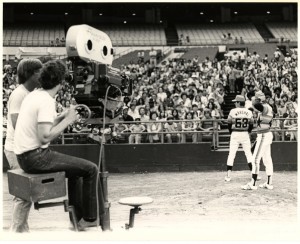
Filming Murder at the World Series (1976) / photo by George Wilkins, Paddock Greater Houston Convention & Visitors Council Records
The second series in this collection contains memorabilia related to the city of Houston and the state of Texas at-large, including bulletins, mailers, programs, and tickets collected by the Paddocks predominantly from the mid to late twentieth century. Of particular interest, and included among these materials, is a recording of the moon landing from 1969.
These materials, further expanding our larger Houston & Texas History Collection, are available for study in the Special Collections Reading Room during our normal summer hours. We look forward to seeing you and assisting you in your research!
Let’s follow recent posts about Kenneth Bentsen’s Philip G. Hoffman Hall (PGH), with a look at his Agnes Arnold Hall (1968) next door. Like PGH, Agnes Arnold is a good modern design and its success has much to do with Bentsen’s use of contrast. An important principle of architectural design, the contrast between thick and thin, heavy and light, solid and transparent enlivens a building’s form.
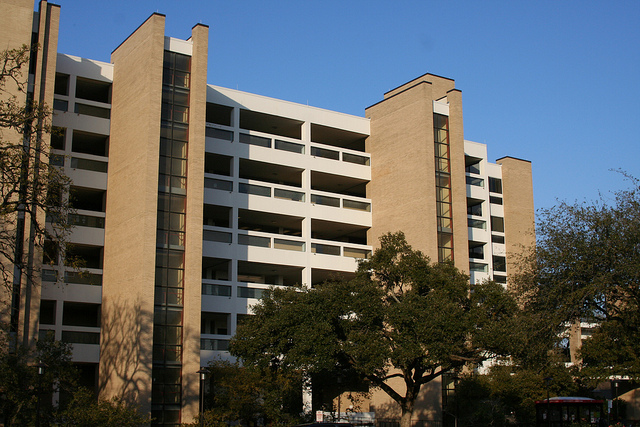
Kenneth E. Bentsen, Agnes Arnold Hall, University of Houston (1968), south elevation (Photo Eric E. Johnson, by permission)
At Agnes Arnold the vertical lines of the towers contrast with the horizontal lines of the stacked classroom levels. The texture and color of the brown brick towers contrasts with the smooth white spandrels and railings. The solid brick contrasts with the transparent glass. Agnes Arnold Hall is also effective because of its layered façade, which is much more sculptural than Bentsen’s very reserved PGH design. Here the architect achieves this sculptural effect by placing the corridors on the edge of the building and opening them to the outside. The surface is cut away and you can see deep within the building.
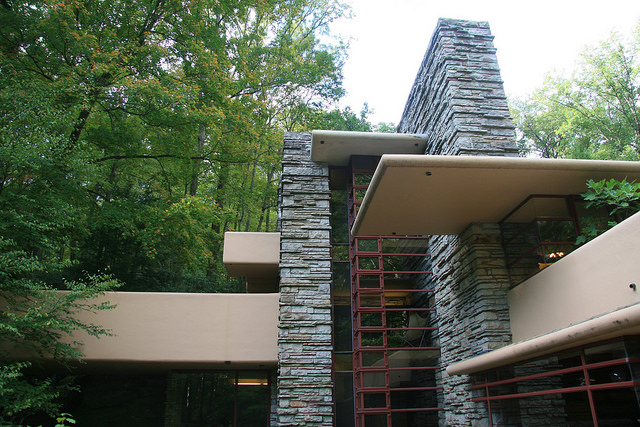
Frank Lloyd Wright, Fallingwater, Bear Run, PA (1936), detail. Photo J.P. Otto, all rights reserved.
You see these same formal principles at work in another successful modern design where contrasting lines, colors, and textures animate the façade of Frank Lloyd Wright’s famous house, “Fallingwater.”
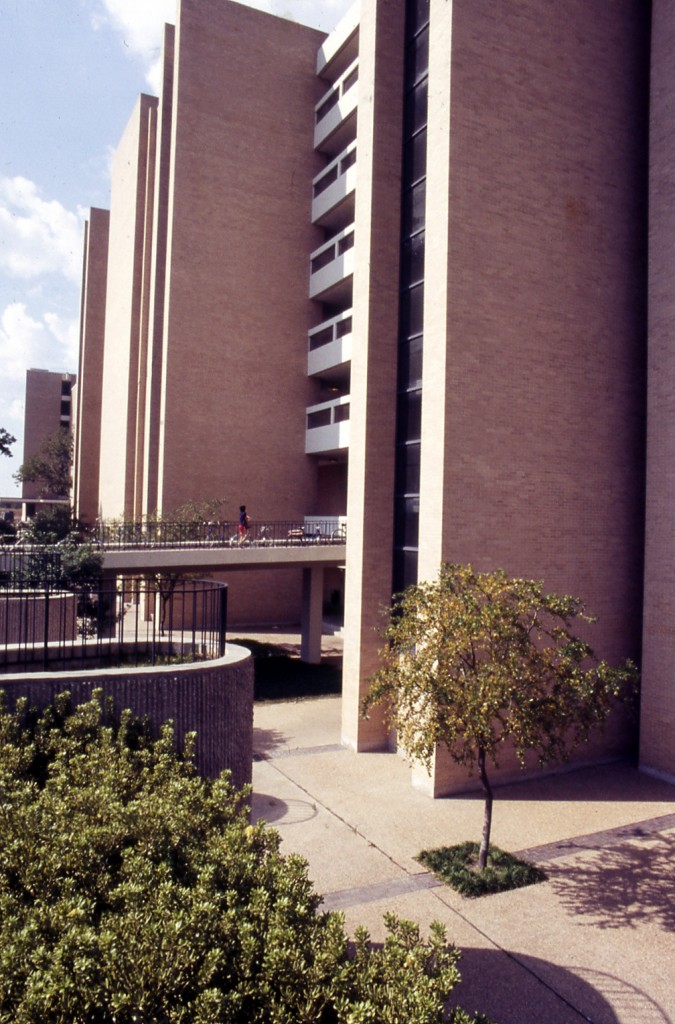
Agnes Arnold Hall is entered from a bridge over the basement courtyard. Kenneth E. Bentsen Architectural Papers
Architects are encouraged to design in three dimensions, not just two. They are intrigued by the idea of space that flows through the building vertically as well as horizontally. You see this in the three-level lobby of Agnes Arnold, where the ground floor is open not just to the level above but to the level below as well. In addition, the building is entered from the south over a dramatic bridge that spans the open courtyard at the basement level. From the street the building appears to rise from an open pit.
The Kenneth E. Bentsen Architectural Papers are housed in the library’s Special Collections department and are currently being processed. Pictures of Agnes Arnold Hall and other campus buildings are available in the University of Houston Buildings Collection of the UH Digital Library.